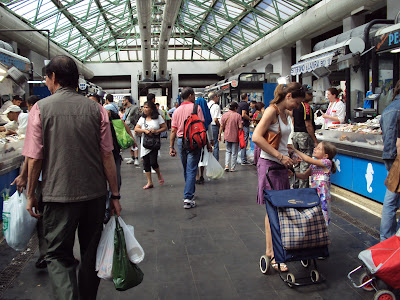One of the things my husband and I enjoy doing is going to the market. Not only is produce cheaper and fresher, but of more interest, the people you see and interact with, the locals, the regular folk. For a moment there, you become a witness to an aspect of their everyday lives, what they buy, how much they pay, the favorite stall, the suki (stall owner) who knows every client, and of course, the haggling.
Everywhere we have lived or visited, we have always made it a point to explore and if time permitted, shop at a local market. Rome was no exception. In Rome, we frequented the Mercato Esquilino.
This market is located in the Esquiline neighborhood, one of Rome's original neighborhoods, atop the Esquiline hill, one of Ancient Rome's famed 7 hills. The market is very close to the Termini Station and very near Piazza Vittoria, the center of Esquilino. The neighborhood is a multicultural melange.
When we first asked for directions to this market, people in my husband's office were unable to help us since none of them ever went to this market. It seemed like this market catered to a certain "class" of people and foreigners like us (who didn't know better?) The first time we went, I was thrilled because to me this area, Termini, and this market seemed to recreate Ancient Rome's Suburra!
It was crowded, crowded with people of different nationalities, ethnicities and even religion. There were Italians, of course, Russians, Eastern Europeans, Asians, Africans and Arabs. Religion? Well, some nuns were buying enough meat and vegetable to feed a congregation, and I also saw a stall selling "halal" meat.
Because of the diversity of it's clientele, one sees some strange food items here, like a goat's head complete with the eyeballs in one of my favorite stalls.
And also an abundance of the innards of cow, sheep, or pig.
My Chinese husband would go crazy buying, tripe and tendon and heart. He told me once that the Chinese don't waste anything, they eat every part of every animal! (Now, that is a story for another day!)
The wet market, selling fish is in another section. Here we were able to buy all kinds of fish, some we were familiar with, others not so much. A favorite of ours was the Sea Bass which we cooked like they do in Rome, baked in salt.
There is also an abundance of shell fish:
In the dry section, fruits and vegetables galore.
Also mushrooms, olives, dates, nuts and of course baccala!
Another section of the market that one cannot fail to notice is the spices section. Here, the air is redolent with the smell of different spices.
Another very interesting thing about this market are the stalls. As the Esquilino has morphed into an immigrant neighborhood, you find stalls catering to specific ethnic groups, selling specialized items, catering to the diverse needs of these immigrants. A true testament to Rome's evolution into a multicultural city.
 |
| "Pinoy Store" |
 |
| Bangladeshi Store |
Beside the wet market, there is an area with a nice garden, where one can have a snack or a cup of coffee before heading home.
As for the haggling, this was carried on in a jovial, light hearted sort of way, not at all like the hardcore haggling one may see in Asian markets.














No comments:
Post a Comment